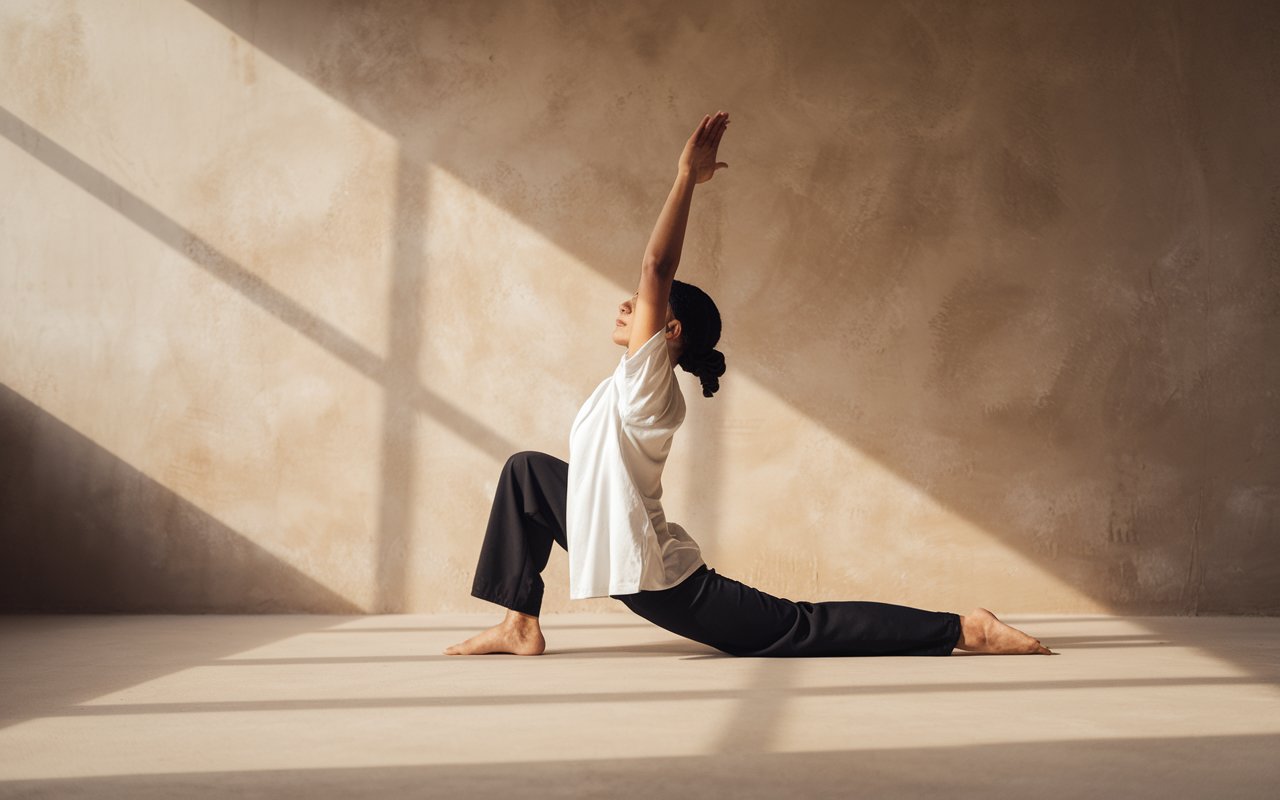Yoga for Beginners:
Introduction
Yoga, an ancient practice originating in India over 5,000 years ago, has evolved into a global phenomenon, celebrated for its physical, mental, and spiritual benefits. While yoga is often associated with flexibility and meditation, it is much more than that—it is a holistic approach to health and well-being. Whether you’re looking to enhance physical fitness, reduce stress, or cultivate inner peace, yoga offers a pathway to achieving these goals.
This guide is designed for beginners, offering a deep dive into the world of yoga, including its history, types, benefits, and practical tips to help you get started.
1. The Origins of Yoga
Yoga’s roots are deeply embedded in the spiritual traditions of ancient India.The term “yoga” is derived from the Sanskrit word “yuj,” which signifies “union” or “connection.” Traditionally, yoga was a spiritual practice designed to harmonize the mind, body, and spirit in the pursuit of enlightenment.
Over the centuries, yoga has evolved, and today, it is widely practiced for its physical, mental, and emotional benefits. The earliest references to yoga can be found in the Rigveda, one of the oldest texts in Indian literature, and later in the Upanishads and the Bhagavad Gita. The practice was systematized by the sage Patanjali in his text, the Yoga Sutras, which outlines the eight limbs of yoga—a framework that still guides yoga practices today.
2. The Eight Limbs of Yoga
Patanjali’s Yoga Sutras present an eight-fold path, known as Ashtanga, which serves as a guide for living a meaningful and purposeful life. Understanding these eight limbs can provide a foundation for your yoga practice:
- Yama (Ethical Disciplines): These are the moral codes that guide your interactions with others.These principles encompass non-violence, truthfulness, non-stealing, self-control, and non-possessiveness.
- Niyama (Self-Discipline): These are the rules for personal behavior, including purity, contentment, discipline, self-study, and surrender to a higher power.
- Asana (Postures): The physical postures practiced in yoga, which help to strengthen and balance the body.
- Pranayama (Breath Control): Techniques that control the breath, enhancing vital energy (prana) in the body.
- Pratyahara (Withdrawal of Senses): Drawing the senses inward, away from external distractions.
- Dharana (Concentration): Focusing the mind on a single point or object.
- Dhyana (Meditation): Sustained concentration that leads to meditation, a deeper state of awareness.
- Samadhi (Union): The ultimate goal of yoga, where the practitioner experiences a state of bliss and oneness with the universe.
3. Types of Yoga
Yoga has branched into various styles and schools, each offering unique approaches to achieving balance and harmony. Here are some of the most popular types of yoga:
- Hatha Yoga: Often considered the foundation of all yoga styles, Hatha focuses on physical postures (asanas) and breath control (pranayama). It’s ideal for beginners due to its slow pace and focus on basic poses.
- Vinyasa Yoga: Known for its dynamic and flowing sequences, Vinyasa synchronizes movement with breath. This style is more physically demanding and is great for those looking to build strength and flexibility.
- Ashtanga Yoga: A rigorous and disciplined practice, Ashtanga follows a specific sequence of postures, linking breath with movement. It’s suitable for those who enjoy a structured approach.
- Iyengar Yoga: Emphasizing precision and alignment, Iyengar Yoga uses props like blocks, straps, and chairs to help practitioners achieve correct posture. It’s excellent for beginners and those recovering from injuries.
- Bikram Yoga: Also known as hot yoga, Bikram consists of 26 postures practiced in a heated room. The heat helps to deepen stretches and detoxify the body through sweating.
- Kundalini Yoga: Focusing on awakening the energy at the base of the spine, Kundalini combines postures, breathing techniques, chanting, and meditation.
- Restorative Yoga: A gentle and relaxing practice, Restorative Yoga uses props to support the body in passive poses, promoting deep relaxation and stress relief.
- Yin Yoga: A slow-paced style that involves holding poses for several minutes, Yin Yoga targets the connective tissues, enhancing flexibility and joint mobility.
4. Getting Started with Yoga: Tips for Beginners

Starting a yoga practice can feel overwhelming, but with the right approach, it can be a rewarding and enjoyable journey.Here are some tips to help you begin your journey:
1. Set Clear Intentions: Before beginning your yoga journey, take a moment to reflect on why you want to practice yoga. Are you seeking physical fitness, stress relief, mental clarity, or spiritual growth? Setting clear intentions can help guide your practice and keep you motivated.
2. Start Slow: If you’re new to yoga, it’s important to start slow and build your practice gradually. Begin with basic poses and focus on mastering the fundamentals before moving on to more advanced postures. Keep in mind that yoga is not about achieving perfection—it’s about making progress.
3. Find the Right Style: With so many types of yoga to choose from, it’s important to find a style that resonates with you. If you’re unsure, try experimenting with different classes and teachers until you find one that suits your needs and preferences.
4. Invest in the Right Gear: While you don’t need much to practice yoga, having the right gear can enhance your experience.Invest in a high-quality yoga mat that offers good support and grip. It’s also important to wear comfortable clothing that allows you to move freely.
5. Focus on Breath: Breath is a central component of yoga. Learning to synchronize your breath with movement can deepen your practice and help you stay present. Practicing pranayama (breath control) exercises can also enhance your lung capacity and improve overall well-being.
6. Be Patient and Consistent: Yoga is a lifelong journey, and progress may be slow at first.Be patient with yourself and stay consistent in your practice. Even dedicating a few minutes to yoga each day can lead to significant improvements over time.
7. Listen to Your Body: Yoga should never cause pain. It’s crucial to pay attention to your body’s signals and respect its boundaries. If a pose feels uncomfortable or painful, gently ease out of it and modify the posture as needed. With time, your flexibility and strength will naturally improve.
8. Incorporate Meditation: Meditation is an integral part of yoga, helping to calm the mind and cultivate inner peace. Begin with short meditation sessions and gradually extend the duration as you become more comfortable.
9. Stay Hydrated and Nourished: Practicing yoga on an empty stomach is recommended, but it’s important to stay hydrated and nourish your body with healthy, balanced meals. Avoid heavy meals before practice, and drink plenty of water throughout the day.
10. Seek Guidance: If possible, practice with a certified yoga instructor who can provide guidance and correct your alignment. Joining a beginner’s class can also be helpful in building a strong foundation.
5. Common Yoga Poses for Beginners

Here are some foundational yoga poses that are perfect for beginners:
- Mountain Pose (Tadasana): A simple standing pose that improves posture and balance.
- Downward-Facing Dog (Adho Mukha Svanasana): A foundational pose that stretches the hamstrings, calves, and shoulders.
- Child’s Pose (Balasana): A resting pose that gently stretches the hips, thighs, and spine.
- Warrior I (Virabhadrasana I): A powerful standing pose that strengthens the legs and core while opening the chest and shoulders.
- Warrior II (Virabhadrasana II): Similar to Warrior I, this pose enhances strength and stability.
- Tree Pose (Vrikshasana): A balancing pose that improves focus and stability.
- Cat-Cow Pose (Marjaryasana-Bitilasana): A gentle flow between two poses that warms up the spine and improves flexibility.
- Bridge Pose (Setu Bandhasana): A backbend that strengthens the back, glutes, and hamstrings while opening the chest.
- Seated Forward Bend (Paschimottanasana):A seated stretch that focuses on the hamstrings and lower back.
- Corpse Pose (Savasana): A relaxation pose that is typically performed at the end of a yoga session to promote rest and recovery.
6. The Benefits of Yoga
Yoga offers a wide range of benefits that extend beyond the physical body. Here’s a look at some of the key benefits:

1. Physical Benefits:
- Improved Flexibility: Regular yoga practice increases flexibility, allowing for greater range of motion and reduced risk of injury.
- Strength Building: Many yoga poses engage multiple muscle groups, helping to build strength and endurance.
- Better Posture: Yoga promotes body awareness, leading to improved posture and alignment.
- Enhanced Balance: Balancing poses in yoga enhance stability and coordination.
- Pain Relief: Yoga can help alleviate chronic pain conditions, including lower back pain, arthritis, and migraines.
2. Mental Benefits:
- Stress Reduction: Yoga helps to reduce stress by promoting relaxation and mindfulness.
- Improved Concentration: The practice of focusing on breath and movement enhances concentration and mental clarity.
- Emotional Stability: Yoga encourages self-reflection and emotional awareness, leading to greater emotional resilience.
- Better Sleep: Yoga can improve sleep quality by calming the mind and reducing tension in the body.
3. Emotional and Spiritual Benefits:
- Increased Self-Awareness: Yoga fosters a deeper connection with oneself, promoting self-awareness and self-acceptance.
- Enhanced Emotional Well-being: The combination of movement, breathwork, and meditation can lead to improved mood and emotional balance.
- Spiritual Growth: For many, yoga is a spiritual practice that cultivates a sense of purpose and a connection to something greater than themselves.
7. Overcoming Common Challenges for Beginners
Starting a new practice like yoga can come with its own set of challenges. Here are some common obstacles beginners face and how to overcome them:
1. Lack of Flexibility: One of the most common misconceptions is that you need to be flexible to practice yoga. Flexibility comes from regular practice, not something you need before you start. Focus on gentle stretches and allow your body to open up gradually over time.
2. Intimidation by Advanced Poses: It’s easy to feel overwhelmed when you see others performing advanced poses. Remember, yoga is a personal journey, and it’s important to honor where you are today. Focus on your own progress and avoid comparing yourself to others.
3. Difficulty in Staying Consistent: Life can get busy, making it challenging to maintain a regular practice. To stay consistent, try to establish a routine by practicing at the same time each day, even if it’s just for a few minutes. Setting small, achievable goals can also help you stay motivated.
4. Finding Time for Practice: If you’re struggling to find time for yoga, start with short sessions and gradually increase the duration as you become more comfortable. Yoga can be practiced anywhere, so even a few minutes of deep breathing or a quick stretch at your desk can make a difference.
5. Managing Distractions: Distractions are a common challenge, especially when practicing at home. To minimize distractions, create a dedicated space for your practice, turn off electronic devices, and let others in your household know you need uninterrupted time.
6. Fear of Judgment: Many beginners feel self-conscious about their abilities, especially when practicing in a group setting. Remember that yoga is a judgment-free zone. Everyone is at different stages in their practice, and the focus should be on your own experience.
8. Creating a Home Yoga Practice
While attending classes can provide valuable instruction and motivation, establishing a home practice is a great way to deepen your yoga journey. Here’s how to create a successful home yoga practice:
1. Designate a Space: Select a quiet, clutter-free space in your home where you can practice without interruptions. Your yoga space doesn’t need to be large, but it should be comfortable and inviting.
2. Set a Schedule: Consistency is key to progress. Try to practice at the same time each day, whether it’s in the morning to energize your day or in the evening to wind down.
3. Gather Your Props: Having the right props can enhance your practice. Invest in a good-quality yoga mat, blocks, straps, and a bolster if possible. If you don’t have props, you can use household items like a belt or a stack of books.
4. Follow Online Classes: If you’re new to yoga or need guidance, there are countless online resources available. Follow along with a video or audio class, or consider joining an online yoga community for support and inspiration.
5. Listen to Your Body: When practicing at home, it’s essential to be mindful of your body’s signals. Don’t push yourself into uncomfortable positions; instead, modify poses as needed and take breaks when necessary.
6. Incorporate Meditation and Breathwork: Yoga is more than just physical postures. Incorporating meditation and pranayama (breath control) into your home practice can deepen your experience and provide additional mental and emotional benefits.
7. Keep a Yoga Journal: Tracking your practice in a journal can help you stay motivated and reflect on your progress. Note how you feel before and after each session, any challenges you faced, and what you’ve learned.
8. Be Patient and Kind to Yourself: Developing a home practice takes time, and it’s important to be patient with yourself. Some days will be easier than others, but the key is to show up consistently and approach your practice with kindness and curiosity.

9. Industry Insights: The Growth of Yoga in the Modern World
Yoga has grown exponentially in popularity worldwide, with millions of practitioners embracing the practice for its myriad benefits. Here are some insights into the current state of the yoga industry:
1. The Global Yoga Market: The global yoga industry is booming, with a market value estimated to reach over $66 billion by 2027. The demand for yoga classes, retreats, apparel, and accessories continues to grow, driven by increasing awareness of the importance of mental and physical health.
2. The Rise of Online Yoga: The COVID-19 pandemic has accelerated the shift towards online yoga classes, making yoga more accessible than ever. Online platforms and apps have made it easier for people to practice yoga from the comfort of their homes, leading to a surge in virtual yoga communities.
3. Yoga for Mental Health: As mental health becomes a growing concern, more people are turning to yoga as a holistic approach to managing stress, anxiety, and depression. Yoga therapy is being integrated into mental health care, offering a complementary treatment for various psychological conditions.
4. Inclusivity in Yoga: The yoga community is becoming more inclusive, with a growing emphasis on making yoga accessible to people of all ages, sizes, and abilities. Adaptive yoga and chair yoga are gaining popularity, catering to individuals with limited mobility or physical challenges.
5. Sustainable Yoga: There’s a growing trend towards sustainability in the yoga industry, with more brands offering eco-friendly yoga mats, clothing, and accessories. Practitioners are becoming more conscious of their environmental impact, and this is reflected in their choices.
6. The Integration of Technology: Technology is playing an increasingly important role in the yoga industry. Wearable devices that track movement and breathing patterns, virtual reality yoga, and AI-powered apps are some of the innovations enhancing the yoga experience.
7. Yoga as a Lifestyle: For many, yoga has evolved from a physical practice to a lifestyle. This includes embracing yogic principles such as mindfulness, ethical living, and a plant-based diet. The rise of yoga-inspired brands and products, from clothing to wellness retreats, reflects this shift.
10. Conclusion: Embarking on Your Yoga Journey
Starting a yoga practice is a transformative experience that can lead to profound changes in your physical, mental, and emotional well-being. Whether you’re seeking to improve your health, reduce stress, or embark on a spiritual journey, yoga offers a path to achieving your goals.
As a beginner, it’s important to approach yoga with an open mind and a willingness to learn. The beauty of yoga lies in its adaptability—there is a style and pace for everyone, regardless of age, fitness level, or experience. By setting clear intentions, practicing consistently, and listening to your body, you can cultivate a practice that supports your overall well-being.
Remember, yoga is not just about the postures—it’s a way of life that encourages self-awareness, compassion, and inner peace. As you continue to explore the world of yoga, you’ll discover that it’s a journey of self-discovery that unfolds with each breath, movement, and moment of stillness.
Whether you choose to practice at home or in a studio, with others or alone, the most important thing is to show up for yourself and embrace the practice with an open heart. Your yoga journey is uniquely yours, and it will continue to evolve as you grow and change. Namaste.




